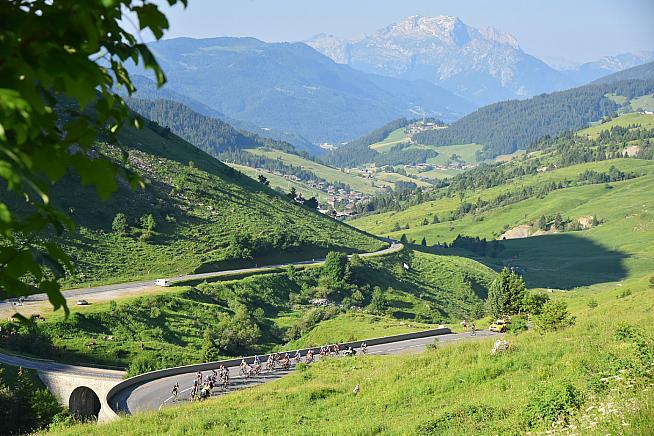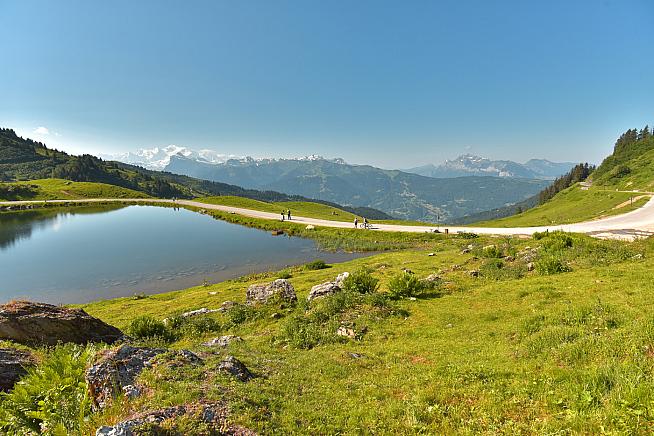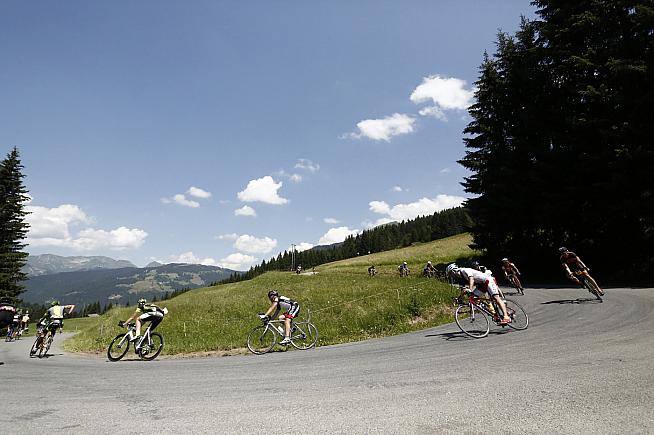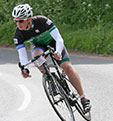Cycling in the Alps is amazing. The quiet roads, epic climbs, and views that take your breath away. We have spent the last five summers at 44South in Morzine, looking after our guests on their road cycling holidays and we've learnt a few things; actually we've learnt a lot, and most of it the hard way.
With hundreds of UK cyclists heading to Europe each year for mountainous sportives like the Etape du Tour and La Marmotte, we thought it would be useful to compile what we've learnt into a single article, to help you get the most from cycling in the mountains.

1. Hills vs Mountains
Riding in the mountains, specifically around Morzine and the Haute-Savoie and Savoie regions of the Alps, is very different to riding most places in the UK. That might sound like a glaringly obvious statement to make, but you'd be surprised how many people measure their ability to climb a mountain against their performance climbing hills in the UK and are subsequently put off.
The two experiences are very different. Highway engineers in the UK took the 'straight up and over' approach; clearly geography dictates road layout; either that, or the road engineers were paid by the job and not the hour!
This has resulted in some very short, sharp hills, often with gradients much steeper than you'll generally encounter in Alps - certainly in the Haute-Savoie and Savoie regions. Generally speaking, climbs in these regions will average between 6% - 8%, compared to the 12% - 20%+ gradients you might find on Leith Hill, Dunkery Beacon, Ditchling Beacon or Hardknott Pass for example. Riding a lower gradient for longer means you can find a comfortable rhythm and pace, and in this respect riding mountains is strangely easier.
2. Training: Long, medium and short term goals
'Well I've done plenty of preparation and training, and now I'm going to reap the rewards' said no cyclist ever.
Booking a cycling holiday is a great way of setting yourself a goal and providing motivation to get out and train, especially on those cold winter days. But sometimes just having a long-term goal invites complacency, and before you know it your trip is almost upon you and you've not nearly done enough training.
Setting yourself a short- and medium-term goal keeps the mind focused, so have a look at the sportive calendar leading up to your trip. Sportives are a great way to set out your path to success. If your holiday is in July, try to aim for a sportive in February, April and June, each of increasing distance.
3. Training: Preparation for the mountains
The best training for riding in the mountains is, well, riding in the mountains. But if you don't have access to a mountain range, train obsessively with a power meter or have a dedicated coach, don't worry - all is not lost.
The best results I've ever had from my pre-Alps training was a winter of long and steady weekend rides. I would do a 150km ride at least once a month from January through to May, and try to squeeze a 90km ride mid-week when the evenings started to draw out, often by commuting to and from work and adding an extra loop on the way home.
These were steady-paced rides, and living in Essex at the time I was riding on mostly flat terrain. But these long rides seemed to set me up really well for the summer, and some of our guests have benefitted from a similar approach.

4. Training: Power to Weight
Your power to weight ratio is a key factor when climbing. Sometimes it is just as effective to lose a little weight as it is building your fitness before heading out to hit the cols; even dropping a kilogram will make a difference.
Although please try not to do this at the cost of staying healthy or bonking on every training ride - you still need to eat!
On which note...
5. Training: Fuelling
Eat sensibly off the bike, but also eat sensibly on the bike. A good mantra while riding is 'Eat now for later', i.e. don't wait until you are hungry to start eating, or you'll be fighting a losing battle keep the muscles topped up with fuel.
Another big mistake many cyclists make is to overeat after a ride, or eat the wrong food - often undoing all that hard work in the saddle.
Eat plenty and regularly during your training rides. If you've fuelled correctly you shouldn't be finishing hungry, and you won't then binge on the wrong foods when you walk through the door. You'll probably end your rides feeling less fatigued too.
6. Fuelling in the mountains
Settling in for a 10km climb is a massive effort on the body, and most of the fatigue you feel when climbing (or later on in your ride) will be down to not eating enough. It's good to be fuelled before you start climbing; obviously having some time to digest before you actually start climbing means the energy your body derives from digestion will be on its way to your muscles.
It's always worth keeping a gel handy too, or equivalent high-energy snack. As soon as you feel your pace drop get it in you, even if you're near to the top. Setting a timer on your bike computer is a great way to make sure you keep food and drink going in; you'll be surprised how quickly five minutes passes when you're climbing.

7. Coping with the heat
I really can't emphasise enough the need to be mindful of heat when cycling in the mountains. Temperatures can hit 40 degrees at times at the height of summer, and riding all day in the sun can literally be lethal.
Keep slapping on the sun cream, and when you stop keep in the shade as much as possible, drink plenty of water and often. Again, setting a timer for 3-4 minute intervals as a reminder to drink will do wonders for your ability to ride in the heat.
8. Beware heat stroke
In the hot summer of 2017 I was riding most days with our guests. I probably didn't make as much of an effort to keep in the shade when we stopped as I should have, although I was drinking and eating plenty and being very liberal with the sun cream.
The fact I was drinking lots seemed to stave off the symptoms of heat stroke until I went to bed, but I woke up at 3am overheating, unable to sweat and having to cover myself with damp towels in order to bring my temperature down. Not pleasant.
I've also seen guests overheat and hallucinate halfway up a climb. This is a very scary experience and came on very quickly and without warning.
9. Cramp
A couple of years ago I set out on the La Morzine Haut Chablais sportive, a punishing ride to rival La Marmotte. I got all the way around to the start of the last climb of the day, the Col de Joux Plane, also featured in the 2016 Tour. I'd been drinking plenty of water as it was a searing hot day, but 2km into the climb the cramp set in.
For the rest of the 10km I couldn't sit on my bike for more than 500 metres before I was on the floor again rolling around in agony. You sweat out a lot of salts, especially if you're riding for several hours, and drinking water alone is not going to replace them - in fact, you're diluting down the remaining salts in your body, contributing to the problem.
This is a common issue in Ironman and similar endurance events, and can in extreme cases be quite dangerous. Since using electrolyte and salt tablets I've not had any problems. Just make sure you carry spares.
10. Pace yourself
Correct pacing on a climb can make or break your whole ride. Taking on a long climb should be done at a pace that is comfortable to you. A common mistake we see all the time is the tendency to push too high a pace.
There's a lot to be said for plodding up a long climb, firstly being able to enjoy the climb for what it is, the views, ambience and not throwing up! But more importantly, having some energy left for the remainder of the ride or the next climb.
If you're gasping for breath, your eyes are popping out of your head or you are chewing on your stem the chances are you're pushing too hard. Ease up, and enjoy the ride!
If you want to experience the alps in the company of like-minded cyclists, knowledgeable hosts and a chilled atmosphere then check out www.44south.co.uk, or email us at [email protected] - we'd love to hear from you.
0 Comments





